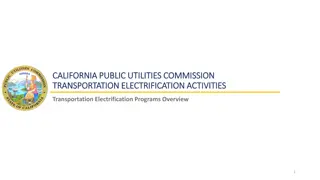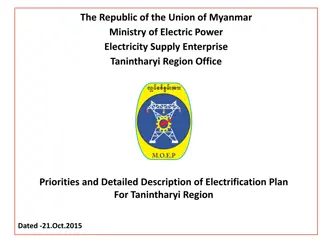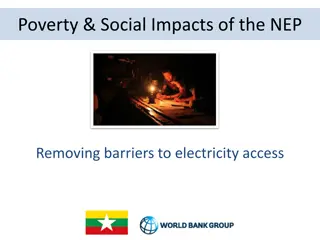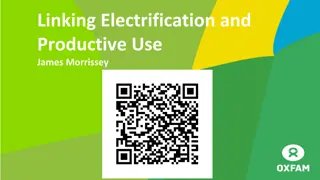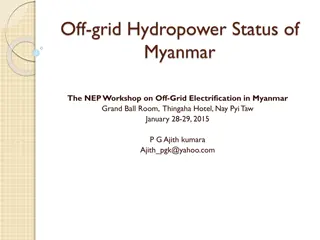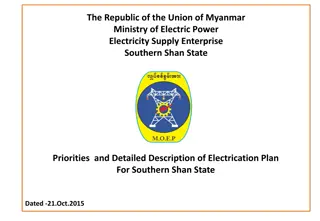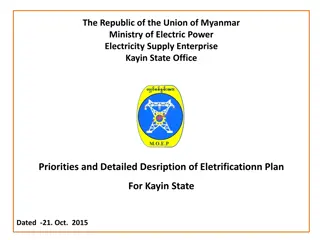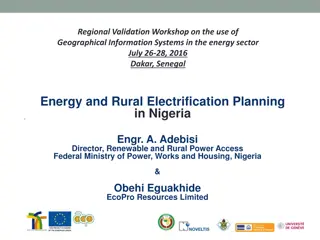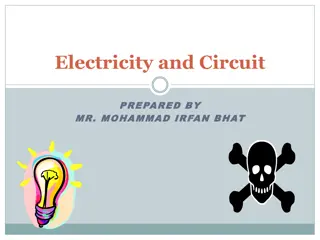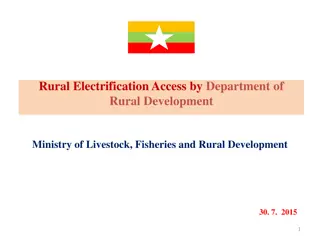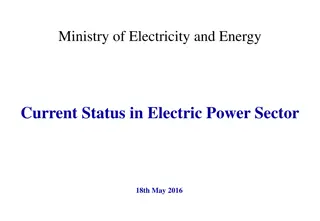Understanding Productive End Uses of Electricity for Rural Electrification Projects
Explore the significance and classifications of Productive End Uses (PEUs) of electricity in rural electrification projects. Learn how supporting PEUs can maximize economic benefits, increase system efficiency, and enhance community sustainability. Discover the impact of PEUs on maintenance practices, watershed preservation, and achieving Sustainable Development Goals (SDGs).
Download Presentation

Please find below an Image/Link to download the presentation.
The content on the website is provided AS IS for your information and personal use only. It may not be sold, licensed, or shared on other websites without obtaining consent from the author. Download presentation by click this link. If you encounter any issues during the download, it is possible that the publisher has removed the file from their server.
E N D
Presentation Transcript
Agenda 1. Introduction to Productive End Uses of Electricity (PEU s) 2. How do we classify Productive End-Uses of electricity? a) Types of productive end uses b) Types of appliances 1. What limitations of mini-grids do we need to be aware of in supporting PEU s? 2. Productive End Use Analysis Tools
Key Terms/Acronyms PEU- Productive End Uses (of electricity)--- an overall term given to activities that use electricity to generate revenue CI- Community Industry a term used to describe community businesses specifically Anchor Load Often but not always a business, anchor loads refer to initiatives that anchor a mini-grid by being the key revenue generator for the system. Historically not community-owned.
Why Support PEUs? 1. 2. PEU s can maximise the economic and social benefits of electricity access PEU s can significantly increase the load factor of the system, decreasing electricity tariffs for the rest of the community Rural electrification projects with a PEU component are more likely to achieve economic sustainability PEU s may increase the desired power output of the system. MH systems have a long lifespan (~25 years) and the power output cannot be easily altered after the system has been commissioned. This is in contrast with modular alternatives such as solar, which can be extended by adding more panels. Therefore, an awareness of PEU s is critical in understanding the community s electricity needs and the projected demand growth over the MH s lifetime 3. 4.
Why Support PEUs? (Contd) 1. PEU s can strengthen community support for the MH system, leading to better maintenance practices, more stringent tariff collection and increased efforts to preserve the watershed PEU s support progression towards the SDG s and positively affect project metrics, giving a competitive advantage in grant applications Some PEU s may offer opportunities to partially finance MH projects independently of grants 2. 3.
Community Business Types This section describes the different types of community industries that can be supported, categorized by size and levels of service.
Type A These CI s seek to provide the community with access to services at a low margin and thus profits are negligible. They are characterised by the fact that they do not stimulate any notable cash flows into the community and have long payback periods on the initial investment required for the business. The investment required to start these enterprises is typically low. Private grants or loans are recommended as financing mechanisms. Definition: The payback period of the business start-up costs is > 2 years. NB: the 2 year limit is determined by the availability of micro loans in Malaysia, which have payback periods of up to 24 months Examples: personal rice mills, village tukang or handyman, ice cream vendor
Type B These PEU s are capable of generating sufficient profits to be financed by a micro loan. This means that the payback period for the business startup costs falls comfortably within the 100 week limit, and profits are high enough to cover the interest rates. Villagers are able and willing to travel to the nearest bank to make frequent payments, have full ownership of the business and are fully liable for the loan. However, these types of businesses still predominantly serve community members themselves or other nearby villages. Definition: The payback period for the start-up costs of the business is < 2 years. After 5 years, profits have recovered less than 25% of the investment required for the business start up costs + the hydro. Examples: Sundry Shop (kedai runcit), bengkel (for repairing vehicles, agricultural equipment), hairdresser
Type C These CI s have the potential to bring considerable cash flows into the community. They are likely to only be feasible in communities with good infrastructure links to export goods, and to be based around a valuable local product. The profits from these businesses are high enough to fund part of the MH system as well as their own start-up costs, making them potential anchor loads/clients. Because of this they are also higher risk, and a joint venture approach with a developer is advisable in order to provide high levels of business support. Definition: The payback period for the start-up costs of the business is < 2 years. After 5 years, profits have recovered more than 25% of the investment required for the business start up costs + the hydro. Examples: Coffee roaster, boutique rice businesses, large handicraft manufacturers. Can also include clinics, learning centers (schools)
Benefits, Support Required, and Risks of Business Types Type A Type B Type C Support Required Low Low High Investor Benefit Low Medium High Community Benefit Medium High High Risk Low Medium High
High Level Process for PEU Integration 1. Identify highest potential PEU s during MH pre-feasibility studies, referencing Tables above If relevant, collect data for business modelling during more in-depth feasibility studies (using COMET and GE tools) Create rough design for the MH and calculate system costs Create business model(s), either by using a template or creating a custom spreadsheet. Several PEU s could be under consideration at this stage. Feedback the PEU power demand into the MH system design Calculate the payback period on the hydro for each of these and therefore their categorisation Make a decision about if/which PEU s will be pursued Use the PEU categorisation to create a strategy for financing and implementing the PEU 2. 3. 4. 5. 6. 7. 8.







